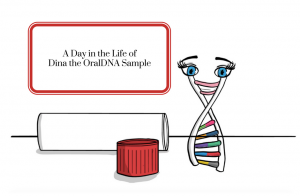
Have you ever wondered what happens to your patient’s saliva sample once it arrives at OralDNA® Labs? Many PDS®-supported offices have been using OralDNA® Labs to analyze the saliva of their patients, relative to the patient’s periodontal infection. This service gives them more information about the types and severity of a patient’s infection, which is the cause of periodontitis. Additionally, however, it tells us something about the bacterial load and a patient’s inflammatory response, which are the basis of how diseases of the mouth relate to systemic disease. This allows them to tailor treatments to help bring the patient’s periodontal disease under control. I was fortunate to be invited by Dr. Ronald McGlennen and Diane Larson of OralDNA® Labs to visit their facility and see the magic in action.
I arrived at the lab in Eden Prairie, Minnesota around lunchtime and was treated to a delicious squash soup. It was the perfectly healthy lunch for the cold Minnesota day. We enjoyed the soup while discussing how OralDNA® Labs is advancing dental care through salivary diagnostics by helping dentists identify the pathogens associated with their patients’ periodontal disease and helping decrease their risk of systemic conditions.
After lunch, they took me on a tour of the lab. Dr. McGlennen explained how the saliva sample starts in the accessioning area where the test information is scanned into the computer and the sample is prepared for testing. From there it moves to the next room where a magnetic biomolecule is introduced to the sample. That biomolecule attaches to the DNA and allows the magnetic beads to separate the component of the human and bacterial cells toward the goal to extract the DNA. Once the strands of DNA are isolated, the DNA samples are used in a process called the polymerase chain reaction or PCR. Here primers and enzymes are introduced that allow specific segments of the bacterial and human DNA to be precisely replicated and increased in amount to a level where they can be more readily analyzed. The process of PCR is performed in an instrument called a thermocycler, which Dr. McGlennen likens to a fancy toaster oven. In the thermocycler, the strands of DNA undergo the series of reactions that are the process of PCR. This includes heating the DNA to separate the double helix into single strands. The strands are then copied and recombined repeatedly until they have enough DNA to observe and identify which bacterial DNA is present in the sample. The analysis of this “amplified DNA” is achieved through a variety of approaches including using fluorescent probes or on a chip that separates DNA by size using capillary electrophoresis. It is interesting to note that this process is all computerized. Laboratory technologists prep the samples for each stage of the process, but the computerized machines do everything from washing and separating the DNA sample, to counting the quantities of bacteria and mapping the human DNA.
It was exciting for me to visit and learn the science behind salivary diagnostics. Given the plethora of research being published on the oral-systemic connection, tests such as those found in OralDNA®’s test menu, allow dentists to truly focus on prevention by identifying and reducing their patients’ risk factors rather than just treating their oral disease. I want to extend a huge thank you to Dr. McGlennen and Diane for being amazing hosts and walking me through the process. If you are ever in Minnesota they have graciously extended an invitation to anyone interested in touring the lab!
For more information on how to become an OralDNA Provider – scan HERE: 
- My Visit to OralDNA® Labs - March 1, 2019

